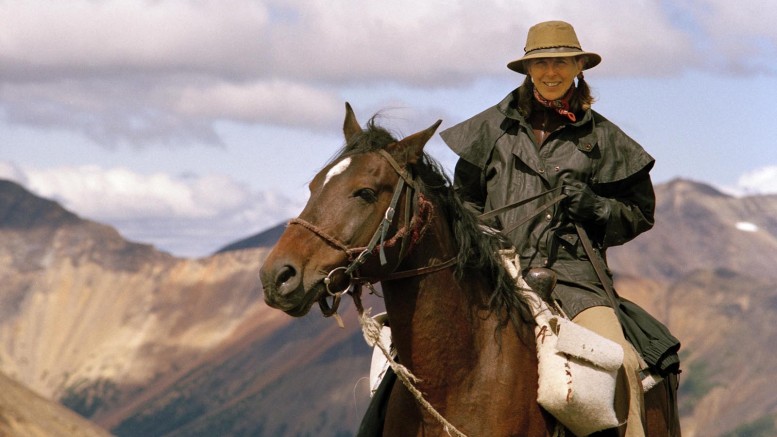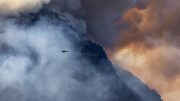Northwest British Columbia is a land of abundance and beauty. Teeming with wildlife, the mountains, rivers and valleys are also home to the Tahltan First Nation. Riches below the surface have inspired miners to call the region the “Golden Triangle.”
This landscape is the focus for Nettie Wild’s documentary KONELĪNE: Our land beautiful. The film-maker points a lens at the people who live and pass through this remarkable land, capturing the intersection of natural beauty, development and a native homeland.

A sunset over Brucejack Lake, near Pretium Resources’ gold project. Credit: Canada Wild Productions.
Konelīne (pronounced koe-ne-lee-neh) is a Tahltan word that means “our land beautiful.” Wild says the one thing everyone in the region shares — from Tahltan elders to prospectors — is a love of the land.
Mineral development in the area can quickly turn controversial, as locals, developers, government and non-governmental organizations enter the mix. Wild captures these tensions while trying to stay above the fray by focusing on the people in the region.

A Tahltan man runs his dogs across a frozen lake. Credit: Canada Wild Productions.

Locals play a stick gambling game. Credit: Canada Wild Productions.
“There are just so many films out there with people telling other people what to think,” Wild said in a phone interview from her home in Vancouver. “This film is not in my voice.”
Viewers meet Tahltan members who are employed by the development industry, as well as those opposed to and unsure about it. The film documents the Tahltan blockade at Imperial Metals’ Red Chris copper project (now a mine), as fears spiked in the aftermath of Imperial’s Mount Polley tailings spill farther south in B.C. in mid-2014.
Lacking overt narration or a heavy-handed agenda, the film, which was shot over a full year, delivers some truly fascinating scenes.
The camera follows a pair of Tahltan hunters in the autumn as they stalk, shoot and butcher a moose. Another segment sees a guide outfitter ferry 17 horses, one by one, across the flowing Stikine River.

Tahltan hunters skin a moose in the documentary KONELĪNE: Our land beautiful. Credit: Canada Wild Productions.

A guide outfitter swims a horse across the Stikine River. Credit: Canada Wild Productions.
The region’s natural beauty is in full view, with breathtaking wide shots, but Wild also finds beauty in unexpected places, artfully capturing diamond drillers pulling up core at Pretium Resources’ Brucejack gold project.
In one of the film’s most gripping scenes, a helicopter delivers a power transmission tower to a crew that struggles to secure it to the ground. Shot in slow motion as the helicopter hovers overhead, Wild calls it an “extraordinary choreographed dance, with linemen, the biggest helicopter in the world and a 16,000 lb. tower.”

Linemen secure a transmission tower to the ground in northwest British Columbia. Credit: Canada Wild Productions.
She hopes the documentary will challenge stereotypes and stop people on all sides from “writing off” those with differing opinions about development, environmentalism and aboriginal issues.
“My role as a film-maker was to go up there and listen really hard to the people in the North. And then, as best as I could, reflect the poetry of their lives and their voices.”
Wild says she inherited a love of the bush from her grandfather, a doctor who caught the mining bug and came to own a tungsten mine near Revelstoke. “The only thing he loved more than fishing and being in the bush was chasing anything that glittered in rock,” she said. The mine never amounted to much, but “as a kid growing up, I had this mythology of what we referred to as ‘the family mine.’
Getting access to film the various regional actors was a challenge, Wild says. Resistance initially came from all sides and threatened to kill the project.
It was Hy-Tech Drilling founder and chairman Harvey Tremblay who first granted filming access, which snowballed into a wider acceptance from people in the region.

A Hy-Tech diamond driller takes in the sunrise at Pretium Resources’ Brucejack gold project. Credit: Canada Wild Productions.
Tremblay admits he was taken aback when he had to sign a document granting full access and independence for the film-maker.
But he said doing so helped ensure the film accurately showed what his drillers do. “We do good work and I feel good about the way we do our work,” Tremblay said in an interview.
“If nobody participates, they’ll make up our part,” he said. “We’re going to be a player in [the film] whether we participate or not.”
Tremblay said the industry should be more transparent about what it does and why, and that informing people about the mining industry will help the public understand its importance. “We should be proud in the mining industry of what we do. We shouldn’t hide what we do — that does us a disfavour.”
Tremblay watched the documentary at its opening in Whitehorse and is pleased with the finished product. He praises Wild for her “balanced hand,” which he believes will promote conversation between concerned groups. “It’s a beautiful film. She did a great job of bringing real poetry to the land. It’s an absolutely stunning, visual movie.”

The Northern Lights above a tower on the Northwest Transmission line in B.C. Credit: Canada Wild Productions.
Tremblay isn’t the only one who was impressed. In May, KONELĪNE won the Best Canadian Feature Documentary Award at the Hot Docs 2016 Festival in Toronto.
The film will play in Toronto from June 10 to 16, and in major cities and mining towns across Canada this year.
The Northern Miner is proud to be Co-Presenter of the film’s Toronto premiere.
To view show times and more information, please visit www.canadawildproductions.com/film/koneline.
View the film trailer on YouTube:






I saw Koneline this afternoon at the Bloor Cinema in Toronto with a few geo and non-geo friends. It is indeed a stunningly beautiful film, superbly photographed, with some high-tech moments that any experienced geologist who has ever worked in the north will recognize (placing those transmission towers: Wow!).
The great achievement of this film to me, apart from the spectacular photography, is that it defuses issues that have pitted the old-guard red-neck bigots in our industry (and there still are far too many amongst us) against First Nation elders who are trying to preserve important cultural values within their homeland. It portrayed very human stories. I have little or no personal patience for band politics in general but, like many of my colleagues, I have spent a lot of time sharing a canvas tent with First Nations guys whose wisdom and subtle sense of humour has been a personal learning experience to me throughout my career as a geologist, since I was a young pup in my 20s. This film, truly, is balanced. And by not taking sides on on-going issues, its focus truly is poetic.
I applaud the NM for supporting this film. It got five stars in the leftist, anti-mining NOW Magazine here in Toronto, and support from the NM. Somebody must have spiked my coffee cup a few days ago with LSD! Who would have thought!
Anyone in our biz who has the opportunity to see this film should do so.
Good on you.
Bill